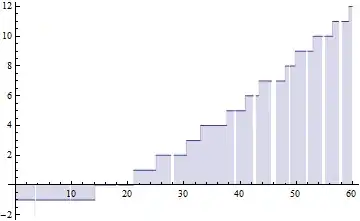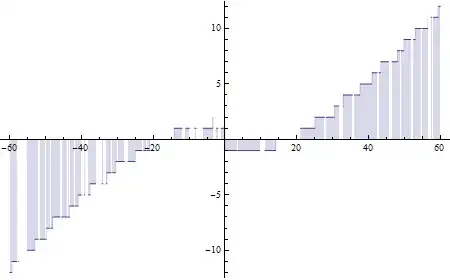In the spirit of Raymond Manzoni's answer in combination with the Franca-LeClair asymptotic of the zeta zeros here, one can arrive at the following almost identical zeta zero counting function:
$$f(t)=\left\lfloor \frac{t \log \left(\frac{t}{2 e \pi }\right)}{2 \pi }+\frac{7}{8}\right\rfloor +\frac{1}{2} \left(-1+\text{sgn}\left(\Im\left(\zeta \left(i t+\frac{1}{2}\right)\right)\right)\right)$$
where only the singularities are different.
The plot looks like this:

Mathematica 8 code for the plot:
(*Mathematica 8*)
Plot[(Sign[Im[Zeta[1/2 + I*t]]] - 1)/2 +
Floor[t/(2*Pi)*Log[t/(2*Pi*Exp[1])] + 7/8], {t, 0, 60},
Filling -> 0]
Just like Raymonds version also this counting function can be made symmetrical:
Plot[Re[(Sign[Im[Zeta[1/2 + I*t]]] - 1)/2 +
Floor[t/(2*Pi)*Log[t/(2*Pi*Exp[1])] + Sign[t]*7/8 +
If[t < 0, 2, 0]]], {t, -60, 60}, Filling -> 0]

Update 13.5.2017:
$f(t)=\frac{\Im\left(\text{log$\Gamma $}\left(\frac{1}{4}+\frac{i t}{2}\right)\right)}{\pi }+\frac{\Im\left(\log \left(\zeta \left(i t+\frac{1}{2}\right)\right)\right)}{\pi }-\frac{t \log (\pi )}{2 \pi }+1$
$f(t)=\left\lfloor \frac{\Im\left(\text{log$\Gamma $}\left(\frac{1}{4}+\frac{i t}{2}\right)\right)}{\pi }-\frac{t \log (\pi )}{2 \pi }+1\right\rfloor +\frac{1}{2} \left(-1+\text{sgn}\left(\Im\left(\zeta \left(i t+\frac{1}{2}\right)\right)\right)\right)+1$
$f(t)=\frac{\vartheta (t)+\Im\left(\log \left(\zeta \left(i t+\frac{1}{2}\right)\right)\right)}{\pi }+1$
$f(t)=\left\lfloor \frac{\vartheta (t)}{\pi }+1\right\rfloor +\frac{1}{2} \left(-1+\text{sgn}\left(\Im\left(\zeta \left(i t+\frac{1}{2}\right)\right)\right)\right)+1$
$f(t)=\left\lfloor \frac{t \log \left(\frac{t}{2 \pi \exp (1)}\right)}{2 \pi }+\frac{7}{8}\right\rfloor +\frac{1}{2} \left(-1+\text{sgn}\left(\Im\left(\zeta \left(i t+\frac{1}{2}\right)\right)\right)\right)+1$
$f(t)=\frac{t \log \left(\frac{t}{2 \pi \exp (1)}\right)}{2 \pi }+\frac{\Im\left(\log \left(\zeta \left(i t+\frac{1}{2}\right)\right)\right)}{\pi }+\frac{7}{8}$
Update 25.5.2017:
In the formulas above:
$\Im\left(\log \left(\zeta \left(i t+\frac{1}{2}\right)\right)\right)=\arg \left(\zeta \left(i t+\frac{1}{2}\right)\right)$
I am not sure all of the formulas are correct but they agree for the first few values I have computed.


